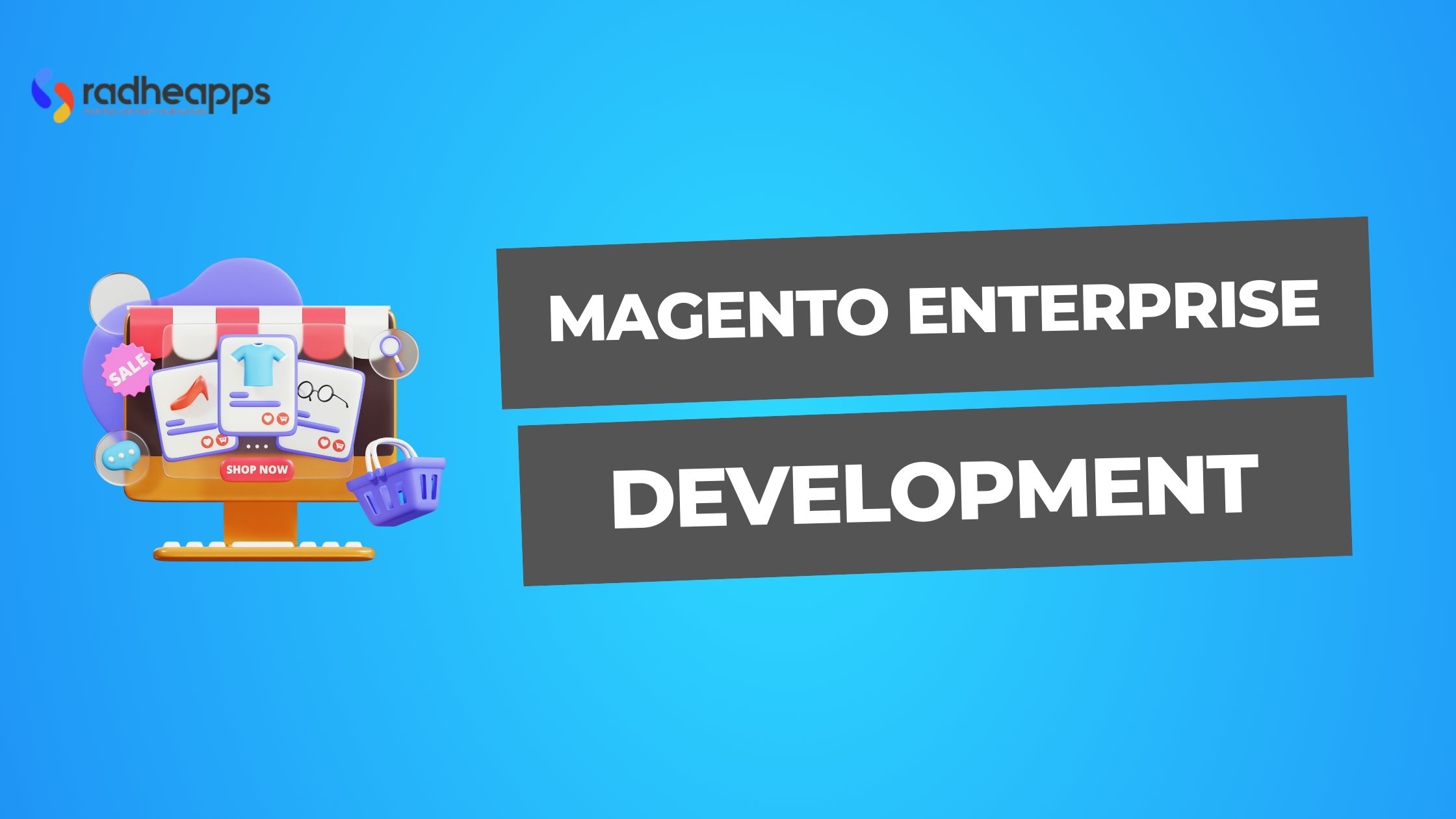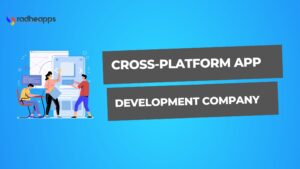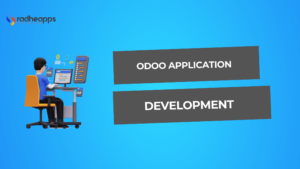An E-commerce store isn’t just about listing products. Customers want speed, security, and a personal touch. The challenge is to deliver all that while staying ahead of the competition.
That’s where Magento Enterprise Solution comes in. Magento powers stores that handle big traffic, advanced features, and constant growth. Big names like Nike and Nespresso trust it for a reason. It’s flexible, customizable, and built to perform. Need to manage thousands of orders? Easy. Want seamless integrations? Done.
So, why choose RadheApps? We’re experts in Magento development. We’ve helped businesses build stores that stand out and succeed. Our team knows how to get the most out of Magento to boost your eCommerce game.
In this blog, we’ll break down why Magento as a platform is a game changer. You’ll see how it helps businesses deliver amazing shopping experiences using Magento.
Let’s dive in!
What is Magento?
Magento is a solid e-commerce platform that helps businesses build, manage, and grow their online stores. It works for everyone, small startups or big companies, and comes with tools to handle all kinds of business needs.
With Magento, you can design a store that looks great and works smoothly on any device. You can hook it up to tools for payments, inventory, or even marketing. Plus, the built-in analytics help you figure out what’s working and where you can improve.
Do you have plans to grow? Magento keeps up, no problem.
It handles more traffic, more sales, and bigger product lists without breaking a sweat. It also has SEO tools and smart marketing features, and lets you manage multiple stores easily. All this makes it perfect for boosting your reach and getting more sales.
The best part? There’s a huge community of developers out there ready to help if you need it.
So, whether you’re just getting started or leveling up your online store, Magento is a smart choice to hit your e-commerce goals.
What are the Key Magento Features?
Magento 1 built a solid foundation While Magento 2 came up with advanced features that were focused on performance, security, and scalability.
However, Magento’s latest version, Adobe Commerce Cloud or Magento Commerce Cloud offers cutting-edge features with immense capabilities to help businesses succeed in this AI age.
Below you will find the key features of Adobe Commerce Cloud:
Inventory Management:
It is one thing to manage the inventory when you are a small business but it’s different when you are a large-scale business. With Adobe inventory management, you can track real-time product availability and visibility to meet your customers’ demand across all channels.
Inventory management lets you handle huge catalogs, millions of SKUs, multiple international locations, and dozens of sources of information.
Headless Commerce:
Adobe Commerce supports Headless API-based architecture to open up a million possibilities for E-commerce-based business. You can customize front-end experience technology at any time.
Simply stating you can unique experience for users based on their device.
The Adobe Commerce Cloud has PWA (Progressive Web Application) which works on all platforms and devices. The benefits of PWA are offline mode, APP lie experience, fast delivery, cost-efficiency, super-speed page-level performance, Higher mobile conversion rates, and Improved SEO.
Most of your consumers are on mobile, so adding PWA can be a great idea.
Limitless Sales and Ads Channel:
With Adobe Commerce, Not only you can sell effectively through your e-commerce store but you can also show yourself on any sales channels and as many channels as possible. You can directly integrate your store on Amazon which is the biggest online marketplace worldwide.
According to Jungle Scout’s Consumer Trends Report, 56% of customers start their online product search on Amazon. This means you will get a chance to sell among 300 Million users with a single integration. With Adobe Commerce you can directly bridge your store with Amazon.
Apart from basic features, Here is the list of advanced features you can get:
- Automatic inventory updates
- Configuration of synchronization rules
- AI-powered intelligence repricing
- Product synchronization
Adobe Sensei:
Adobe Commerce gives you the tools to grow your e-commerce store without the headaches. With their AI system, you can boost sales and keep things running smoothly.
The product recommendations? Smart and simple.
It shows customers popular, trending, or similar items and tracks which ones sell best. Live search is another win. It delivers fast, personalized results and creates filters like “trending” or “recommended for you” based on what customers actually do.
You also get business intelligence tools that pull all your data into one place.
The dashboards and reports are easy to customize and share. Need a CSV, PDF, or PNG for a meeting? No problem. Plus, you can control who on your team sees what with permission settings.
Managing your store becomes a whole lot easier. With smart insights and automation, Adobe Commerce helps you work better, not harder.
Types of Magento Development
Magento Enterprise Cloud
Magento Enterprise Cloud is a cloud-hosting solution for enterprise-level e-commerce businesses.
This enables you to stall your website on a network of virtual and physical servers that are outside of your premises. It is for businesses looking for scalability, fully managed service, and a comprehensive package.
Magento eCommerce Development
Magento e-commerce development is the process of creating an e-commerce store with the help of the Magento platform. This combines both the Community Edition (CE- the free version) and the Enterprise Edition (EE- the paid version), focusing on creating tailored e-commerce solutions for every size of business.
Magento eCommerce Solutions
Magento provides Robust solutions for B2B and B2C. Magento can help you create and manage your online store according to your various needs. Whether you are a small-scale;e startup or a scale business it has got you covered. Below you find more about different types of solutions.
Magento B2B Commerce
Magento B2B commerce (now known as ADobe commerce,) lets you create scalable and flexible e-commerce platforms as per your B2B needs. No matter how many brands you want to cover.
Whether you have CMS, ERP, or CRM you can smoothly integrate into your existing tech stack so you will be ready to scale your business.
Magento eCommerce Design
Magento e-commerce development refers to the process of developing an e-commerce store. It is useful especially when you want to serve your customers an online experience. With its wide range of features, it has huge potential. Keep reading and you will see the potential of Magento.
Magento Website Development Process – Checklist
Before you dive into building your website, make a checklist. It’s a simple but powerful way to stay on track and avoid headaches later. A good checklist helps you:
- Get clear about your goals.
- Keep your branding consistent.
- Make sure everything works the way it should.
- Catch errors before they mess things up.
- Set yourself up to rank well on search engines.
- Launch without a hitch.
- Create a website that performs well long-term.
Step 1: Requirement Analysis
- What will be the site’s structure and site map to organize the content reasonably?
- Do you want to use a pre-designed theme or do you want to create a unique custom design?
- If you are using a theme, write down customization requirements in detail.
- If you are creating a custom design, specify your preferred brand colors, styles, and layouts.
- Write down the default and custom functions needed within Magento.
- Identify which Magento extensions you need to enhance site functionality.
- Choose a payment gateway provider and Magento payment methods to ensure compatibility.
- Write down the shipping carriers and methods or integrate custom solutions if you need them.
- Write down the Magento site’s supported languages, currencies, and the currency used for payments in detail.
- Write down if you need third-party integrations, such as ERP or CRM systems.
- Set up a project timeline with important milestones.
- Write down where the site will be developed- the developer’s or the customer’s server.
Step 2: Front-end Development
- If you choose a pre-designed theme, start adding branding assets like logos, banners, and color preferences.
- Modify the Magento theme design as required to align with your brand.
- Offer 1-3 design options for a custom design, review wireframes, and prototypes.
P.S.: Once the design is approved, frontend Magento developers start crafting the website.
The duration of this phase can range from 1 to 2 months, depending on the complexity and expertise of the outsourced Magento team.
Step 3: Backend Development
- Customize default Magento functionality to match your specific business requirements.
- Create custom functions if needed to address unique business needs.
- Install and adjust Magento 2 extensions to improve site performance.
- Incorporate selected payment gateways and shipping carrier systems.
- Adjust site settings, including language, currency, store information, and email templates.
- Bring in essential product data, including categories, images, SKUs, descriptions, quantity, and pricing,
- Develop crucial Magento CMS pages to engage and inform customers.
Step 4: Testing
- Start performing internal testing where the development team systematically evaluates each project phase based on predefined requirements and test cases. Here, a quality assurance manager conducts a final review before presenting the project to you.
- Start involved in user acceptance testing, where you, as the site owner, actively evaluate the final result.
- Send feedback, report errors, and request improvements to the development team.
Step 5: Site Optimization
- Take on feedback and apply necessary changes.
- Optimize site speed, performance, and SEO elements if needed.
- Again, the Magento Site owner approves the website’s final version and cautiously reviews all essential pages and functions.
Step 6: Deployment & Launch
- Deploy or transmit the code from the development site to the live server.
- Form the connection between the Magento site and its domain.
- Begin Magento promotional campaigns to attract customers to the new site.
- Implement Magento marketing strategies as planned.
Step7: Website Maintenance and Support
- Post-release (typically 1 to 3 months), maintain communication with the developers of your Magento hosting providers for ongoing support.
- Resolve any post-launch issues promptly.
P.S.: Keep in mind to collaborate with Magento hosting providers that offer free support during the initial months after the site’s launch.
Magento Website Development – Step-by-Step Process
Step 1: Find Magento Stack Requirements
When your system specifications match or exceed Magento system requirements, it operates optimally. This ensures a smoothly functioning e-commerce store. Here they are:
Requirements for Magento:
- Operating system: Linux x86-64: Recommended distributions are Red Hat Enterprise Linux, CentOS, Ubuntu, and Debian.
macOS: Suitable for local development environments only.
- Web Server: Apache 2.4 or higher or Nginx 1. x.
- Memory: At least 2GB RAM is required for basic functionality however, for Magento extensions and installations more is recommended.
- Database: MySQL 8.0+ or MariaDB 10.6+.
- PHP: PHP 8.2 or 8.3
- Security: Valid SSL certificate (Self-signed SSL certificates not supported) and Transport Layer Security (TLS) for PayPal integration
- Mail Server: Requires a Mail Transfer Agent (MTA) and Simple Mail Transfer Protocol (SMTP) server.
Step 2: Choose Your Web Hosting and Domain Name
You need to have web hosting and a domain name if you want to launch your website.
You can choose hosting from Magento Hosting. Here are some things you need to consider when choosing a host.
- Pick one that matches your needs and supports your Magento system requirements.
- Make sure your chosen hosting provider offers both Magento speed and security to prevent any potential security risks and provide a seamless experience for your customers.
- Be cautious when selecting a hosting provider; opting for the cheapest option can compromise security. While being costlier does not always mean superior quality, It is advisable to consider a renewed hosting provider.
P.S: Registering your domain name with a similar hosting provider is recommended for streamlined management.
Step 3: Download and Install Magento
The next step is to install Magento. To do this, create an account on Adobe’s official website to access Magento installation resources. After that follow this official installation guide.
Step 4: Set up Store Settings
After installing Magento, the next step is to adjust essential Magento platform settings.
Here is how you can do it:
- Gain entry to your Magento dashboard and proceed to Stores > Configuration > General to set up fundamental settings.
- Here you will find details such as Country, State, Timezone, Store Name, Phone Number, Address, and more.
- After this, make sure all basic settings are up-to-date to start your store setup.
Step 5: Choose a Theme for Your Store
After adjusting the basic settings of your store, the next step is to define the visual identity of your Magento e-commerce store. To achieve this, you have to first select and implement the theme. Here are the two options you have:
- Opting for default theme: You can choose a default Magento theme that is 100% FREE. It’s These themes will be a great starting point. You can further customize them to match your Brand kit.
- Look into Marketplace Themes: If the default Magento themes aren’t suitable for your brand kit, you can acquire a new theme from Magento Marketplace. Conversely, you can obtain themes from platforms like Envato or Themeforest to enhance your Magento e-commerce development.
Step 6: Install Required Extensions
It’s time to boost your stores’ functionality by installing some fundamental extensions.
You can start this by evaluating your specific business needs and requirements.
Here is the simple two-step procedure you can go through with:
- First, identify the important extensions that align with your store’s necessities.
- After identifying the extensions, start installing the extensions.
P.S: For instance, by integrating Magento Payment extensions you can secure payment collection at your online store.
Step 7: Import or Create Products
Now that you have installed extensions, it’s time to add products to your store with Magento import products. Follow this 9-step process to achieve this:
- Reach the Magento admin panel and go to System > Import.
- Choose the products as the Entity type in the Import settings section and identify the Download Sample File link.
- Download the sample file and organize your actual product CSV file similarly for a successful import.
- Navigate to the Import Behavior section and select one of the options: Add/Update, Replace, or Delete from the Import Behavior dropdown.
- Organize additional settings and proceed to the File to Import section.
- Select the CSV file comprising your product data.
- Validate the data by clicking the Check Data button. An Import button will appear if everything is in order.
- Click the Import button to import your products successfully.
- Setup Payments and Shipping Options
Step 8: Setup Payments and Shipping Options
Follow the setup Magento shipping and payment methods:
For Shipping Methods
- Reach your Magento dashboard and proceed to Stores > Configuration > Sales > Delivery Methods.
- Here, you will three primary shipping methods: Flat rate, Table rate, and Free Shipping.
- Each shipping method offers customizable settings. You can customize these settings to your specific shipping requirements.
Payment Methods
- Deploy your Magento dashboard and proceed to Stores > Configuration > Sales > Payment Methods.
- Look into various payment methods, including Zero Subtotal Checkout, Cheque/Money Order, Bank Transfer Payment, and Cash on Delivery.
- You can integrate popular payment gateways like Braintree, PayPal, Authorize.net, and more by downloading their corresponding extensions to expand payment options.
Step 9: Evaluate and Launch Your Store
Before launch, check that all components are correctly aligned within your online store. Implement complete testing of your website across various facets, including speed, responsiveness, checkout process, reporting, and more. Once you reviewed that everything functions seamlessly, launch your website for revenue generation.
Step 10: Track Store Performance
Use tools like Google Analytics and Magento’s reporting capabilities to track your online store’s performance, Analyzing key performance indicators (KPIs) allows you to pinpoint areas for enhancement and make informed, data-driven decisions to foster business growth.
Step 11: Sustain Your Store
Maintaining the operation of your e-commerce website demands regular maintenance. It includes updating the Magento core and extensions, addressing common issues, and seeking Magento technical support when necessary. These things will help you to run your online store smoothly and securely.
5 Benefits of Hiring a Magento Development Company
Thinking about taking your e-commerce store to the next level?
Hiring a Magento development company can make all the difference.
Let’s break down the top benefits so you know what you’re getting:
Expert Advice
A certified Magento developer knows what works and what doesn’t. They don’t just build websites, they guide you on the best ways to make your store stand out.
Their experience helps you avoid pitfalls and ensures your site looks great and performs even better.
Need a trusted partner? Radheapps specializes in Magento development and can help you create a store that works perfectly for your business.
Flexible Solutions
Every business is unique. A Magento development company can create customized solutions that match your goals. Whether it’s adding your brand’s look and feel or tweaking functionalities to fit your vision, they make sure your store stands apart from competitors.
Ongoing Support and Maintenance
Building your site is just the start. Many Magento service providers, including Radheapps, offer regular updates, security patches, and performance checks. You’ll have peace of mind knowing your store stays secure and runs smoothly over time.
Focus on Quality
No one likes bugs or glitches. That’s why Magento agencies test everything before launch. They fix issues early, so you get a reliable and polished website that works well from day one. This saves time and headaches later.
Scalability for the Future
Your business will grow and your site should grow with it. A professional Magento developer delivers scalable solutions that adapt to your needs. Whether it’s adding new features or expanding into new markets, they make sure your store is ready for what’s next.
Ready to level up your online store? Get in touch with Radheapps today and let them help you create an amazing Magento-powered e-commerce site.
Frequently Asked Questions (FAQs)
How Does a Magento Developer Support My Project?
Following are some ways in which a Magento Developer will support you:
1. You will get technical support such as in maintenance, customization, and migration
2. You will get support for constant security audits, vulnerability assessment, and Patch management.
3. They will also be with you during the time of user experience customization.
4. You will also get 24/7 support.
How Is Magento eCommerce Web Design Customized?
Magento eCommerce web designing can be done in several ways. It offers product customization, it allows store appearance and functionality customization, It also enormous number of extensions and plugins, and last but not least, you can even tweak with user experience.




